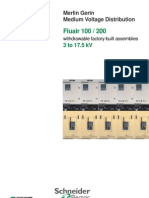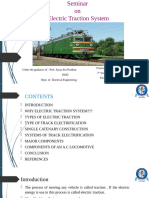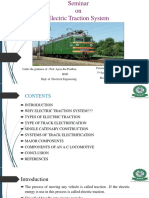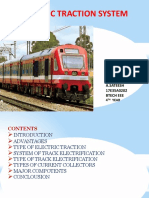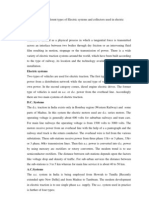0 ratings0% found this document useful (0 votes)
12 viewsTraction
Traction
Uploaded by
romanreings1874The document discusses different types of electric traction systems used in transportation including DC, AC, and composite systems. It describes the components, advantages, and disadvantages of each system.
Copyright:
© All Rights Reserved
Available Formats
Download as PDF, TXT or read online from Scribd
Traction
Traction
Uploaded by
romanreings18740 ratings0% found this document useful (0 votes)
12 views18 pagesThe document discusses different types of electric traction systems used in transportation including DC, AC, and composite systems. It describes the components, advantages, and disadvantages of each system.
Original Description:
Electric traction
Original Title
Traction.pptx
Copyright
© © All Rights Reserved
Available Formats
PDF, TXT or read online from Scribd
Share this document
Did you find this document useful?
Is this content inappropriate?
The document discusses different types of electric traction systems used in transportation including DC, AC, and composite systems. It describes the components, advantages, and disadvantages of each system.
Copyright:
© All Rights Reserved
Available Formats
Download as PDF, TXT or read online from Scribd
Download as pdf or txt
0 ratings0% found this document useful (0 votes)
12 views18 pagesTraction
Traction
Uploaded by
romanreings1874The document discusses different types of electric traction systems used in transportation including DC, AC, and composite systems. It describes the components, advantages, and disadvantages of each system.
Copyright:
© All Rights Reserved
Available Formats
Download as PDF, TXT or read online from Scribd
Download as pdf or txt
You are on page 1of 18
Electric Traction
• The action of pulling something over a surface (especially a
road or a track) is known as traction.
• The action of drawing of vehicles by electric power derived
from overhead wires, storage batteries or diesel generators
mounted on the vehicles is known as electric traction.
• The traction system which uses electric power for its
operation is known as electric traction.
• The electric traction system is widely used in electric trains,
tramcars, trolley buses and hybrid vehicles, etc.
• Advantages of Electric Traction
• Cleanliness − Electric traction is free from smoke and flue
gases, etc. Therefore, it is most suitable type of traction
system to be used for underground and tubular railways.
• Less starting time − Electric locomotives can be stating
without any loss of time.
• Less maintenance cost & time − The maintenance cost of an
electric traction system is about half of that of steam traction
system and also the time required for maintenance is quite
low.
• High starting torque − The motor used in electric traction is
DC series motor or AC series motor which has a very high
starting torque. Hence, the electric locomotives has very high
acceleration.
• High traffic handling capacity − As the electric locomotives
have high acceleration which makes the traffic handling
capacity almost double of that of the steam locomotive.
• Require lesser terminal space − As the electric traction has high traffic
handling capacity. Therefore, it needs lesser terminal space because quicker
disposal of passengers to destination is there and hence gathering is
reduced.
• Regenerative braking is possible − In case of electric traction system
regenerative braking can be applied which feeds back about 80% of electrical
energy to the supply. Also, due the presence of electric braking, there is less
requirement of mechanical braking. Thus, maintenance cost of brake shoes,
wheel types and rails get reduced on account of less wear and tear.
• Center of gravity − Height of electric locomotive is quite less as compared to
steam locomotive which results in lowering of center of gravity. This makes
the electric locomotive more suitable for taking curvy turns at higher speeds
safely.
• Saving in high grade coal − The use of electric locomotive saves high grade
coal which is quite deficient in India. Electrical energy required for running
electric locomotives is taken either from hydro-electric power station or
thermal power station which uses low grade coal for electricity generation.
• Electric traction has high power-to-weight to ratio.
• The electrification of railway encourages rural electrification.
Disadvantages
• Electric traction has high capital cost due to overhead
equipment, so electric traction becomes uneconomical unless
heavy traffic is to be handled.
• In electric traction, a power failure for few minutes causes
distortion in traffic.
• Electric traction can be used only at the places which are
electrified.
• Electric traction is tied to electric routes.
• Power lines for electric traction causes disturbance in
neighboring communication lines.
System of Electrification for Traction
• Based on the availability of
1. Supply
2. Area of track electrification and
3. Type of electric traction service (mainline, urban, or suburban)
• Following track electrification or electric traction systems are
employed,
1. DC Traction System,
2. AC Traction System,
3. Three-phase AC Traction System,
4. Composite Traction System.
DC Traction System
• In the dc traction system, dc series motors are employed due to their
high starting torque.
• The operating voltage range of the motor lies between 1500-3000V.
• However, dc compound motors with operating voltage at 600V are
also used for tramways and trolleybuses where regenerative braking
is required.
• Usually, an ac supply at a voltage range between 33kV to 100kV is
fed to the substation.
• The substation is equipped with a transformer to step down the
voltage level and rotary converters to convert ac power into dc
power.
• Then after the dc power supply is fed to the locomotive through an
overhead conductor.
• Advantages of DC System
• The characteristic of DC series motor is better than ac traction
motor.
• Maintenance cost is low
• The weight of DC motor per HP is less in comparison to ac
motors
• Better speed control.
• In a dc traction system, rail act as a return conductor, thus only
one conductor is used.
However in this case the overall cost will be more because of
heavy cost of additional equipment eg. Converting machinery,
boosters etc.
Single Phase AC Systems
• In this traction system, ac power is supplied to the locomotive.
• Generally, ac series motors with operating voltage in the range
of 300V-400V at 16 2/3 or 25Hz frequency are used.
• A voltage level in the range of 15kV to 25kV at normal
frequency is fed to the overhead distribution wire from the
substation.
• Later in the locomotive, the high voltage is stepped down to
300V-400V at a frequency of 16 2/3 or 25Hz using a step-down
transformer and frequency changer.
Advantages
• Rapid acceleration and retardation have less effect on the
system.
• Less cost.
• Low-frequency operation improves commutation, efficiency,
and power factor of ac series motor.
• Low-frequency operation reduces the line reactance and
hence voltage drop.
Three Phase AC traction
• In a three-phase traction system, three-phase induction
motors operating at 3000 to 3600V at a frequency of 16 2/3
Hz are used.
• Two overhead conductors are used and the track acts as the
third conductor.
• Three-phase induction motors have to be built to operate at
moderately high voltages. The line voltage may be chosen
such that the motors may be supplied directly from the
overhead wires.
• The sub-station receives power at a high voltage where it is
stepped down and converted to the desired frequency.
• Advantages of Three-Phase Traction System :
• Three-phase induction motors are simple, robust, and
efficient with low-cost regeneration.
• Disadvantages of Three-Phase Traction System :
• Difficult to collect current from overhead conductors.
• Induction motors have low starting torque, high
starting current, and difficult speed control. However,
these drawbacks can be overcome by using power
electronics based circuits.
• The induction motors have almost constant speed
characteristics which are not suitable for a traction
system. However, speed control can be achieved by
cascade connection and pole-changing methods.
Composite System
• This system combines the advantages of dc and ac
(three-phase/single-phase) systems.
• Single-phase system is preferred due to a better distribution
system and easy current collection.
• Hence, in a composite system, power distributed to the
locomotive is single-phase ac wherein it is converted to
three-phase or dc at the required level.
• There are two types of composite systems as given below.
• 1. Single-Phase to Three-Phase System
• In this system, single-phase power at 15kV, 50Hz is transmitted
to the locomotive.
• The single-phase supply will be converted to a three-phase
supply by a phase converter and fed to a three-phase
induction motor on the locomotive.
• Power electronics based inverter circuits are used to generate
ac at low frequency i.e., 10Hz.
• At low frequency, the three-phase induction motor develops
high starting torque without drawing excess current from the
supply.
• Speed control can also be obtained by varying the supply
frequency.
Advantages of single-phase ac to three-phase ac traction system
• The difficulty of collecting current in a three-phase system can
be overcome.
• Less expensive than a three-phase distribution network.
• The design of the substation is simple and flexible in substation
location.
• 2. Single phase AC to DC system
• Single-phase power supply at 15kV to 25kV, 50Hz is distributed
and fed to the locomotive.
• The locomotive is equipped with a transformer that will step
down the voltage. This stepped-down voltage is fed to a
converter which converts ac to dc.
• The dc thus generated will be fed to a dc traction motor.
Advantages of a single-phase ac to dc traction system
• Due to high voltage distribution. This reduces the
cross-sectional area and hence the cos, line current for a
given power rating is reducedt of supporting structure is
also reduced.
• DC series motors have ideal traction characteristics for
getting the required propelling power.
• Disadvantages of a single-phase ac to dc traction
system
• Single-phase ac system imposes unbalance on the power
supply system.
• Interference with communication lines.
You might also like
- F200Document18 pagesF200Mohammed Madi100% (2)
- Ieee Gold Book Standard 493 2007Document3 pagesIeee Gold Book Standard 493 2007Patricia25% (4)
- MRS (Main Receiving Substation)Document4 pagesMRS (Main Receiving Substation)Rahul Gautam100% (4)
- Saudi Electricity RegulationDocument103 pagesSaudi Electricity Regulationvijay babu100% (2)
- Electric Traction PDFDocument54 pagesElectric Traction PDFLalit ChaudharyNo ratings yet
- Electric Traction SystemDocument23 pagesElectric Traction SystemAniket Likhar100% (1)
- Electric Traction: BY Viswanath 267Document22 pagesElectric Traction: BY Viswanath 267Viswanatha SharmaNo ratings yet
- Electric Traction: A Seminar OnDocument20 pagesElectric Traction: A Seminar OnEmmaniel rock100% (2)
- UEE Unit 4 - GKDocument44 pagesUEE Unit 4 - GKRajvir Kaur SidhuNo ratings yet
- Electric Traction: LocomotionDocument29 pagesElectric Traction: LocomotionRaja SekaranNo ratings yet
- unit4_traction-part 1Document77 pagesunit4_traction-part 1Sashank AvinashNo ratings yet
- SensorandtransducerDocument12 pagesSensorandtransducerdivya brahmaNo ratings yet
- 2 - UtilisationDocument13 pages2 - UtilisationAditya PaulNo ratings yet
- Nani PPT On TractionDocument21 pagesNani PPT On TractionLovely TarakNo ratings yet
- PratikDocument16 pagesPratikAkshayNo ratings yet
- ELECTRIC TRACTION PPT Vishnuprasad 18032076 Eee s5Document20 pagesELECTRIC TRACTION PPT Vishnuprasad 18032076 Eee s5Murali krishnanNo ratings yet
- Notes Chapter 1Document8 pagesNotes Chapter 1bagathariya dharaNo ratings yet
- Electric TractionDocument23 pagesElectric Tractionyatendra kashyapNo ratings yet
- Unit Iv Traction & BrakingDocument26 pagesUnit Iv Traction & BrakingsiddharthaNo ratings yet
- Railway ElectrificationDocument4 pagesRailway ElectrificationSuman Pathak50% (2)
- Electric Locomotives: By: Aman YadavDocument18 pagesElectric Locomotives: By: Aman YadavAman Yadav100% (1)
- Unit 5 Electric TractionDocument25 pagesUnit 5 Electric Tractionmahato4120No ratings yet
- Electrical Energy Utilisation and Management - Electric TractionDocument42 pagesElectrical Energy Utilisation and Management - Electric Tractionmadhu balanNo ratings yet
- Electric Traction Systems 205Document3 pagesElectric Traction Systems 205Vyaghri KotturiNo ratings yet
- On Systems of Track ElectrificationDocument12 pagesOn Systems of Track Electrificationdivya brahmaNo ratings yet
- Electrical LocomotivesDocument22 pagesElectrical LocomotivesNikhil JainNo ratings yet
- Electrictraction-160911144155 - (1) (1) - Read-OnlyDocument27 pagesElectrictraction-160911144155 - (1) (1) - Read-Onlysurjyakantsahoo123No ratings yet
- Guided By: Prof. Ankit Shahpatel: Utilization of Electrical Enenrgy and TRACTION (2160907)Document16 pagesGuided By: Prof. Ankit Shahpatel: Utilization of Electrical Enenrgy and TRACTION (2160907)sameerpatel15770100% (1)
- Electric Traction Presented By: Piyush Kumar 10EEE023Document23 pagesElectric Traction Presented By: Piyush Kumar 10EEE023nagarjunareddy100% (1)
- Under The Guidance Of: Prof. Ajoya Ku Pradhan HOD Dept. of Electrical EngineeringDocument27 pagesUnder The Guidance Of: Prof. Ajoya Ku Pradhan HOD Dept. of Electrical Engineeringishfaq222100% (1)
- Traction IntroductionDocument21 pagesTraction Introductionc_h_v_k_rNo ratings yet
- Electric Traction SystemsDocument4 pagesElectric Traction Systemsmaheswari M100% (1)
- EE037-3.5-2 EPU L12 Electric Traction-P1Document33 pagesEE037-3.5-2 EPU L12 Electric Traction-P1Neeraj NagaNo ratings yet
- Unit Types: History of Indian RailwayDocument5 pagesUnit Types: History of Indian RailwaysukhadiadarshanNo ratings yet
- Electric Traction in RailwaysDocument10 pagesElectric Traction in RailwaysTahamee SHAIKHNo ratings yet
- Electric TractionDocument21 pagesElectric Tractionnagarjunareddy100% (1)
- EpgtDocument43 pagesEpgtdarshan arkasaliNo ratings yet
- 202004092006210179pavan Engg Electrical Traction 2Document6 pages202004092006210179pavan Engg Electrical Traction 2VikasNo ratings yet
- A.sateesh 17-202Document17 pagesA.sateesh 17-202Naresh GadidasulaNo ratings yet
- 21EEE01 Utilization & Conservation of Electrical EnergyDocument17 pages21EEE01 Utilization & Conservation of Electrical EnergyWizardNo ratings yet
- Expt No.6 Electric TractionDocument7 pagesExpt No.6 Electric TractionPriyanka MauryaNo ratings yet
- UNIT-IV MATERIALDocument36 pagesUNIT-IV MATERIALSashank AvinashNo ratings yet
- ETC_CH-1Document16 pagesETC_CH-1Frency ButaniNo ratings yet
- Uee 3Document29 pagesUee 3SURAJ KUMAR PATRANo ratings yet
- Utilization of Electric PowerDocument8 pagesUtilization of Electric Powerits RoddurNo ratings yet
- MET Notes Unit 1, 2 and 3 PDFDocument161 pagesMET Notes Unit 1, 2 and 3 PDFparneet chowdharyNo ratings yet
- Unit 1Document46 pagesUnit 1parneet chowdharyNo ratings yet
- TC of Electric LocomotivesDocument20 pagesTC of Electric LocomotivesRaminder Singh SoodNo ratings yet
- EHV CHP 3Document7 pagesEHV CHP 3pravinkushwaha2004No ratings yet
- Lec2 Characteristics of Railroad Locomotives & TrainsDocument35 pagesLec2 Characteristics of Railroad Locomotives & Trainsم.علي سعدي الجنابيNo ratings yet
- Chapter 1Document66 pagesChapter 1Akshay KatharNo ratings yet
- Module 1 - FinalDocument47 pagesModule 1 - FinalSUMADEEPIKA BALAGARINo ratings yet
- Submitted By: Janmejaya Sahu Regd No:0801214182 Branch: Electrical Date: 6 Sept, 2011Document15 pagesSubmitted By: Janmejaya Sahu Regd No:0801214182 Branch: Electrical Date: 6 Sept, 2011Dev KumarNo ratings yet
- RAYLI SİSTEM ARAÇLARI24eylülDocument126 pagesRAYLI SİSTEM ARAÇLARI24eylülAli SevenNo ratings yet
- ADRA - Railway TrainingDocument15 pagesADRA - Railway Trainingswastik hazraNo ratings yet
- Train Lighting SystemDocument15 pagesTrain Lighting Systemhjhj0% (1)
- EPUT Module 4 EnglishDocument18 pagesEPUT Module 4 EnglishVedant PandeyNo ratings yet
- Intenship in Traction Motor ShedDocument16 pagesIntenship in Traction Motor ShedPallav PantNo ratings yet
- Utilasation of Electrical Energy: Lecture NotesDocument57 pagesUtilasation of Electrical Energy: Lecture NotesNarendra VermaNo ratings yet
- Electric Traction SystemDocument7 pagesElectric Traction SystemFariha shaikhNo ratings yet
- Traction Motor 1Document47 pagesTraction Motor 1IC QUEENNo ratings yet
- Electric TractionDocument52 pagesElectric Tractionranjit mallickNo ratings yet
- TractionDocument26 pagesTractionYogesh GurjarNo ratings yet
- Methods for Increasing the Quality and Reliability of Power System Using FACTS DevicesFrom EverandMethods for Increasing the Quality and Reliability of Power System Using FACTS DevicesNo ratings yet
- Maintenance of Operation Faults of Distribution Line in Power SystemDocument3 pagesMaintenance of Operation Faults of Distribution Line in Power SystemADIL BASHIRNo ratings yet
- 01-02 Introduction To The BBU3806Document8 pages01-02 Introduction To The BBU3806tonzkosgeiNo ratings yet
- Components of Overhead Distribution SystemDocument9 pagesComponents of Overhead Distribution SystemReginald L. CamineroNo ratings yet
- EE301 Power Generation Transmission and Protection PDFDocument3 pagesEE301 Power Generation Transmission and Protection PDFMalavika SNo ratings yet
- Lab1 EPS FinaDocument13 pagesLab1 EPS FinaJorge Nelson75% (4)
- Unit 3Document17 pagesUnit 3parthhbiswasNo ratings yet
- Reconfiguration of MV Distribution Networks With Multicost and Multipoint Alternative Supply, Part II Reconfiguration Plan 2017490216Document7 pagesReconfiguration of MV Distribution Networks With Multicost and Multipoint Alternative Supply, Part II Reconfiguration Plan 2017490216sanafayaz12No ratings yet
- Smart GridDocument90 pagesSmart Gridjose girotNo ratings yet
- How Is ELECTRICITY Transmitted and DistributedDocument5 pagesHow Is ELECTRICITY Transmitted and DistributedJustine PamaNo ratings yet
- Automatic Under-Frequency Load Shedding in New ZeaDocument8 pagesAutomatic Under-Frequency Load Shedding in New ZeaShubham MeharkureNo ratings yet
- Allowed Charges For LECO For 2019Document6 pagesAllowed Charges For LECO For 2019lkwriterNo ratings yet
- Low Voltage EquipmentDocument174 pagesLow Voltage EquipmentFarid NazriNo ratings yet
- Edn HJ Uiom BVDocument129 pagesEdn HJ Uiom BVIrfan UllahNo ratings yet
- Duke Energy Fast FactsDocument2 pagesDuke Energy Fast FactsetggrelayNo ratings yet
- Subtransmission Systems: Noornabi ShaikhDocument9 pagesSubtransmission Systems: Noornabi ShaikhAwesh KumarNo ratings yet
- L-1-Power Distribution & UtilizationDocument109 pagesL-1-Power Distribution & Utilizationhassaan tanveerNo ratings yet
- Design of Electrical InstallationsDocument32 pagesDesign of Electrical InstallationsScribdTranslationsNo ratings yet
- Company Profile ABB - Final FIle PDFDocument28 pagesCompany Profile ABB - Final FIle PDFAliyyus Sya'niNo ratings yet
- Declaration FormsDocument2 pagesDeclaration FormsVaibhav JainNo ratings yet
- Mep DBR CompilationDocument88 pagesMep DBR Compilationbrad_4u_4ever100% (2)
- Implementing Regulations of The Electricity LawDocument61 pagesImplementing Regulations of The Electricity LawRaul FenrandezNo ratings yet
- Registered Electrical Engineer 04-2022Document110 pagesRegistered Electrical Engineer 04-2022PRC Baguio100% (2)
- Electrical Disturbances in LV Networks Due To Energization of MV NetworksDocument5 pagesElectrical Disturbances in LV Networks Due To Energization of MV NetworksAlejandro Solis GomezNo ratings yet
- P19 P19R Provisinal Timetable Even2324Document17 pagesP19 P19R Provisinal Timetable Even2324SS20CO005 Amisha SawantNo ratings yet
- Underground Cable MCQDocument42 pagesUnderground Cable MCQshukla dhaval100% (1)
